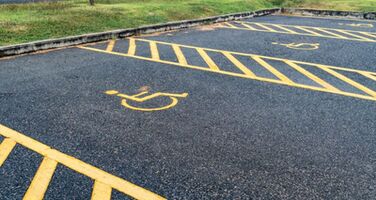
Handicap Placard vs. Handicap License Plates: Which is Right for You in Utah?
Introduction
Living with a disability presents unique challenges, but the state of Utah offers valuable resources to assist those in need of accessible parking solutions. Two primary options are Handicap Placards and Handicap License Plates. Understanding the differences between the two is essential to ensure you choose the right option that caters to your specific requirements. In this comprehensive guide, we will explore the features, benefits, regulations, and processes for obtaining both Handicap Placards and Handicap License Plates in Utah. Let's delve into the details to help you make an informed decision.
Handicap Placard vs. Handicap License Plates: What's the Difference?
When it comes to accessible parking, the main difference between Handicap Placards and Handicap License Plates lies in their display and usage.
Handicap Placard:
A Handicap Placard is a portable permit that you hang from your rearview mirror when you need to use accessible parking spaces. It is designed to be easily transferred between vehicles, providing flexibility for individuals who may use multiple cars or have family members who drive them.
Handicap License Plates:
Handicap License Plates, on the other hand, replace your standard license plates on the vehicle. These plates feature the International Symbol of Access (ISA) and grant you the right to park in designated accessible spots without the need for a placard. Handicap License Plates are a permanent solution that remains with the vehicle at all times.
Eligibility Criteria for Handicap Parking in Utah
Before deciding whether to apply for a Handicap Placard or Handicap License Plates, it is crucial to understand the eligibility criteria set by the state of Utah. The Department of Motor Vehicles (DMV) has specific requirements that must be met to qualify for either option.
To be eligible for a Handicap Permit or Handicap License Plates in Utah, you must:
- Have a disability or medical condition that significantly impairs mobility.
- Be unable to walk 200 feet without stopping to rest.
- Need the assistance of a mobility aid, like a wheelchair, cane, crutch, or another person.
- Have a doctor, physician assistant, or nurse practitioner certify your eligibility by completing the necessary medical form provided by the DMV.
Applying for a Handicap Placard
Obtaining a Handicap Placard in Utah is a straightforward process. Follow these steps to apply:
- Download the "Application for Disabled Person Parking Placard" form from the Utah DMV website or obtain a physical copy from your local DMV office.
- Have your medical provider complete and sign the medical certification section of the application.
- Submit the completed application by mail or in person to your local DMV office. Be sure to include any required fees as stated on the application.
Applying for Handicap License Plates
If you prefer the convenience of Handicap License Plates, follow these steps to apply:
- Obtain the "Application for Personalized or Replacement License Plates" form from the Utah DMV website or your local DMV office.
- Have your medical provider complete the medical certification section of the application.
- Complete the form, ensuring all required information is provided.
- Submit the application in person to your local DMV office and pay any applicable fees.
Handicap Placard vs. Handicap License Plates: Pros and Cons
Both Utah Handicap Placards and Handicap License Plates have their unique advantages and disadvantages. Understanding these can help you make an informed decision.
Handicap Placard Pros:
- Portability: Can be easily transferred between vehicles.
- Cost-effective: Typically less expensive than Handicap License Plates.
- No vehicle restrictions: Can be used in any vehicle you are traveling in.
Handicap Placard Cons:
- Easily misplaced: Due to their portability, placards may be more prone to being misplaced or forgotten.
- Not permanent: May require frequent renewal depending on your medical certification.
Handicap License Plates Pros:
- Permanent fixture: Always available on the vehicle and less likely to be forgotten.
- No renewal needed: Once obtained, they remain valid as long as you maintain eligibility.
- Allows access without placard: No need to hang a placard when parking in designated accessible spots.
Handicap License Plates Cons:
- Cost: Usually more expensive to obtain compared to placards.
- Vehicle-specific: Can only be used on the vehicle they are registered to.
Frequently Asked Questions (FAQs)
Q: Can I apply for both a Handicap Placard and Handicap License Plates?
Yes, you can apply for both, but you will need to provide separate documentation for each application. However, you may only display either the Handicap Placard or Handicap License Plates while parking, not both simultaneously.
Q: How long does the application process take?
The processing time for both Handicap Placards and Handicap License Plates can vary. Generally, you should receive your placard within a few weeks after submitting the application. For license plates, it may take longer due to production and mailing times.
Q: Can I use my Handicap Placard or License Plates in other states?
Yes, Handicap Placards and License Plates issued in Utah are generally recognized in other states. However, it is essential to check the specific rules and regulations of the state you are visiting, as they may have slight variations.
Q: How do I renew my Handicap Placard or License Plates?
Both Handicap Placards and Handicap License Plates require periodic renewal. To renew your placard, simply complete a new application and medical certification form and submit it to the DMV. For license plate renewals, you will follow the same process as standard license plate renewals.
Q: Can I lend my Handicap Placard or License Plates to someone else?
No, your Handicap Placard or License Plates are issued specifically for your use. Lending them to someone else, even if they have a disability, is against the law and can result in penalties.
Q: What should I do if my Handicap Placard is lost or stolen?
If your Handicap Placard is lost or stolen, you should report it to your local DMV office immediately. They will guide you through the process of obtaining a replacement.
Conclusion
When it comes to choosing between Handicap Placards and Handicap License Plates in Utah, it ultimately depends on your specific needs and preferences. Both options offer valuable accessibility benefits, so carefully consider the pros and cons outlined in this guide. Ensure you meet the eligibility criteria, and follow the application process to secure the right option for you. Remember that both Handicap Placards and Handicap License Plates aim to make your life more manageable by providing you with convenient and designated accessible parking spaces.
.png)






